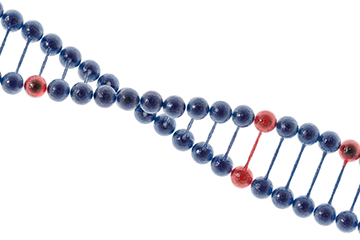
Researchers have devised a simple method to test whether disease risk may be influenced by rare DNA variants.
The work provides a new tool for geneticists who are trying to tease apart the combination of genetic and environmental factors that determine a person’s risk of developing a complex disease, such as type 2 diabetes and schizophrenia.
The results were recently published online in The American Journal of Human Genetics.
“Researchers are embarking on a long journey to find potentially important rare genetic variants. Our simple method can help predict whether that journey is likely to succeed for a particular disease,” said principal investigator Joel Hirschhorn, Harvard Medical School Concordia Professor of Pediatrics at Boston Children’s Hospital and a senior associate member of the Broad Institute.
Most common diseases are not caused by a single gene, but rather by many genes and environmental factors. Genome-wide association studies, or GWAS, have been good at identifying genetic variants—places in the DNA that vary from person to person—that appear in 5 percent or more of people with a particular disease, but those common variants only partly explain disease risk.
The missing risk could be hidden in a number of different places, including rarer variants or as-yet undiscovered common variants. Unfortunately, it has been difficult to determine the individual risk contributions, if any, of rarer variants, especially those that occur in less than 1 percent of the population.
Geneticists have compiled lists of rarer variants that are marginally associated with specific diseases, but determining whether each variant increases risk or is just “noise” requires sequencing an even larger number of patients, which can be expensive and time-consuming.
The new tool from Hirschhorn’s team provides an initial indication of whether rarer variants are likely to contribute to disease risk by looking at them collectively. The test searches existing GWAS results for a particular statistical imbalance that may be hiding in the data.
“You look at whether they ‘lean’ toward risk as a group,” said Hirschhorn. “Even variants that don’t reach rigorous levels of statistical significance still have a direction of effect. They are like undecided voters who, when you ask them which way they might vote, show a definite preference as a group toward one candidate.”
“If the disease you’re studying is explained only by common variants, then our test will show a balance between the number of rarer variants that increase risk and those that decrease risk; they are probably just noise,” said Yingleong (Rigel) Chan, a member of the Hirschhorn lab and first author of the paper. “But if you run the test and see an imbalance where more than half of the rarer variants show increased risk for the disease, then this suggests that rarer variants may be playing a role.”
A positive result does not prove low-frequency variants are contributing to disease risk—confounding factors can mimic a signal, and the analysis won’t reflect variants that haven’t been identified yet—but it offers a clue that the hypothesis might be worth pursuing.
“As GWAS statistics continue to pour out, our test puts one more tool in the researcher’s toolbox to help them decide whether they should devote substantial effort to searching for rare variants that contribute to different diseases,” said Hirschhorn.
Hirschhorn’s team, which included collaborators from Massachusetts General Hospital and three institutions in Helsinki, Finland, ran the test on GWAS data from studies of several different diseases. They found evidence that rare variants contribute to risk in some diseases, including type 2 diabetes and schizophrenia, but not others, such as major depression.
The team also analyzed pairs of apparently similar diseases to see if the signal persisted, suggesting the diseases share rarer variants, or if the signal disappeared, suggesting different variants contribute to each disease. The test remained positive when Crohn’s disease and ulcerative colitis were analyzed together, suggesting they share rarer genetic causes. But when the team analyzed two manifestations of diabetic kidney disease, macroalbuminuria and end-stage renal disease, the signal faded, suggesting that the diseases have different sets of causal rarer variants and that they should be studied separately.
“Our method may help guide the design of future genetic studies of different diseases,” said Hirschhorn.
The findings could also have repercussions for the search for rare protective variants, which are more difficult to find but can be especially helpful in suggesting avenues for new therapies.
Support for this work was provided by National Institutes of Health grants R01DK075787 and R01DK081923.


